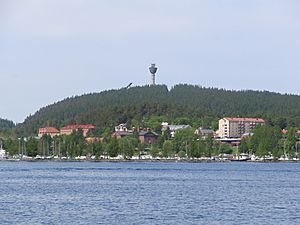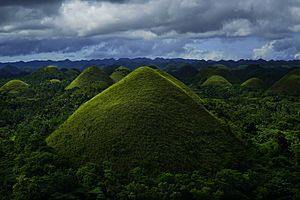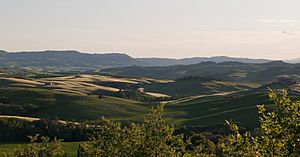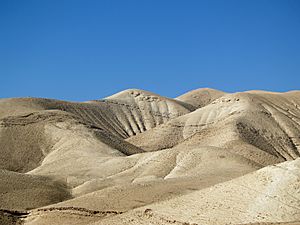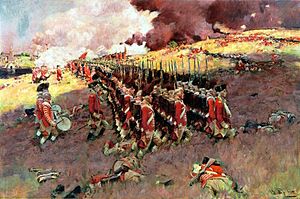Hill facts for kids
A hill is a natural rise in the land that is higher than the ground around it, but not as tall or steep as a mountain. Think of it as a smaller version of a mountain. Hills usually have a more gentle slope, making them easier to climb. Unlike dunes, which are made of loose sand, the surface of a hill is much more stable.
Contents
What is a Hill?
It can be tricky to say exactly what makes a hill different from a mountain! Different groups and countries have their own ideas. For example, some people might call a landform a mountain if it's taller than 2,000 feet (610 m), while others might say it's a mountain if it's over 1,000 feet (300 m).
In the United Kingdom and Ireland, a mountain is often defined as a peak at least 2,000 feet (610 m) high. The official UK government definition is a summit of 600 metres (1,969 feet). But sometimes, even very tall peaks in Scotland are called "hills," like the Cuillin Hills.
A very small hill is often called a hillock or a knoll.
How Hills are Formed
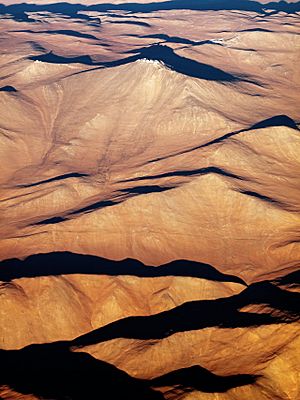
Hills can form in many ways due to natural processes on Earth.
- Earth's Movements: Sometimes, the Earth's crust moves and cracks, pushing land upwards to create hills.
- Erosion: Large landforms like mountains can wear down over time due to wind and water, leaving smaller hills behind.
- Glaciers: Huge sheets of ice called glaciers can move and drop sediment (like dirt and rocks), forming hills called moraines and drumlins.
- Weathering: Solid rock can break down into smaller pieces and form hills.
- Soil Movement: The rounded shape of hills often comes from soil and loose rock slowly moving downhill over many years.
There are also special names for different types of hills, often based on how they look or where they are found:
- Brae: A term used in Scotland and northern England for a hillside.
- Butte: A hill with steep sides and a small, flat top, often found in dry areas.
- Drumlin: A long, whale-shaped hill made by glaciers.
- Puy: A cone-shaped volcanic hill, often seen in France.
- Tor: A rock formation on a hilltop, also used to describe the hill itself, especially in England.
- Pingo: A mound of earth-covered ice found in very cold places like the Arctic.
Why Hills are Important
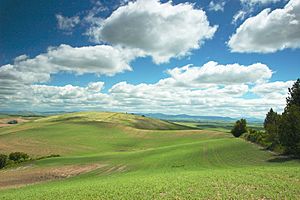
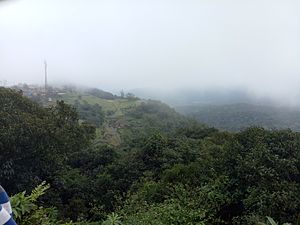
Hills have been very important throughout history for many reasons:
- Safety from Floods: Early settlements were often built on hills to stay safe from floods, especially if they were near rivers or lakes.
- Defense: Hills offer a great view of the surrounding land, making it easier to spot enemies. Attacking uphill is also much harder for an army. This is why many ancient cities, like Ancient Rome (which was built on seven hills), were built on high ground.
- Avoiding Forests: Sometimes, people built on hills to avoid thick forests that were hard to clear.
Some settlements, especially in the Middle East, are built on "tells." These are artificial hills made from layers of old buildings and debris that have piled up over many generations.
In Northern Europe, many ancient monuments and hillforts were built on hills. Some were for defense, while others were likely important religious or meeting places. Many churches in Britain are built on hilltops, possibly on the sites of even older sacred places.
Hills in Military History
Hills give a big advantage in battles. An army on a hill can shoot down at enemies, and it's much harder for attackers to charge uphill. Hills can also hide soldiers, allowing them to surprise an enemy. Because of this, armies often try to control the highest ground.
Many famous battles have been fought on hills:
- The Battle of Alesia in 52 BC.
- The Battle of Bunker Hill in 1775 during the American Revolutionary War. This battle was actually fought on Breed's Hill.
- Cemetery Hill and Culp's Hill were key locations in the 1863 Battle of Gettysburg during the American Civil War.
- The Battle of San Juan Hill in 1898 helped Americans gain control of Santiago de Cuba.
Battles for high ground can be very difficult and lead to many losses, like the 1969 Battle of Hamburger Hill during the Vietnam War.
The Great Wall of China is a famous example of hilltop defense. It was built along hilltops to help protect against invaders from the north.
Hills and Fun Activities
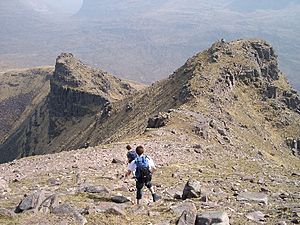
Hills are great for many outdoor activities:
- Hillwalking: This is a popular activity in places like the Peak District in England and the Scottish Highlands. It's like hiking, but specifically involves walking up hills. It's different from mountaineering because it doesn't usually involve ropes or difficult rock climbing.
- Peak Bagging: Some people enjoy climbing hills from special lists, like "Munros" in Scotland or "Wainwrights" in England, with the goal of climbing every hill on the list!
- Cheese Rolling: The Cooper's Hill Cheese-Rolling and Wake is a unique event in England where people chase a wheel of cheese down a very steep hill. The person who catches the cheese wins it!
- Cross Country Running: Many cross country races include hills, which make the courses more challenging and exciting.
Notable Artificial Hills
Some hills are not natural; they were built by people! These are often called mounds.
- Sophienhöhe, Germany (200 m (660 ft))
- Monte Kaolino, Germany (120 m (390 ft))
- Malminkartanonhuippu, Finland (91 m (299 ft))
- Mausoleum of the First Qin Emperor, China (76 m (249 ft))
- Silbury Hill, England (40 m (130 ft))
- Monks Mound, Illinois (30 m (98 ft))
Images for kids
-
Cerro Paranal in Chile is a privileged place for astronomical observation, and home of ESO's telescopes.
-
Maungakiekie / One Tree Hill is a prominent feature of the skyline of Auckland, New Zealand.
-
A coffee plantation on a conical hill near Orosí, Costa Rica.
-
An arrow pointing towards the top of the Malminkartanonhuippu hill in Helsinki, Finland.
-
The archaeological hill of Qasr shamamk in Erbil
-
The archaeological hill of Aliawa in Erbil
See also
 In Spanish: Colina para niños
In Spanish: Colina para niños
- Abyssal hill
- Dune
- Hillock
- Hill station
- Kame
- King of the Hill
- Mesa
- Mound
- Tell



